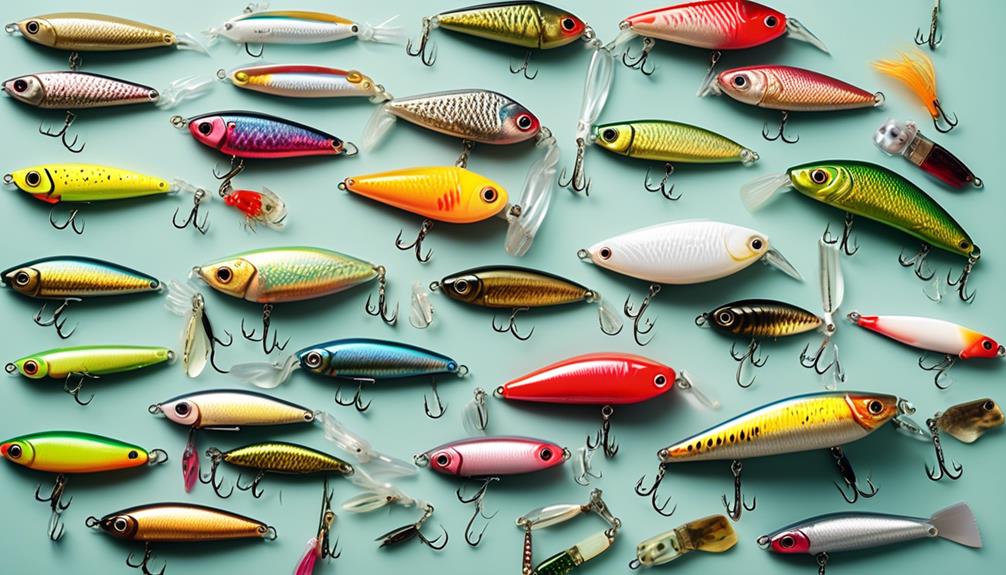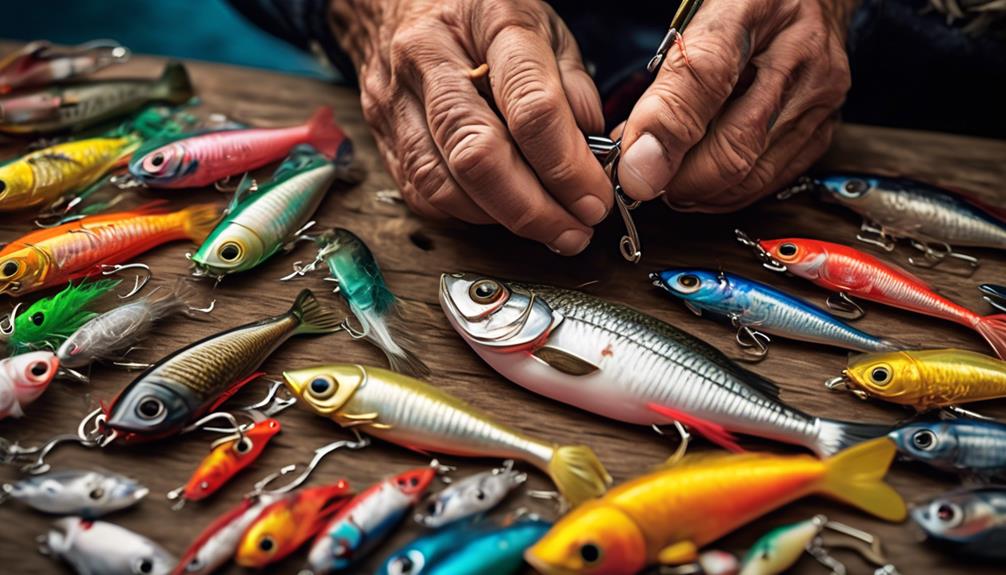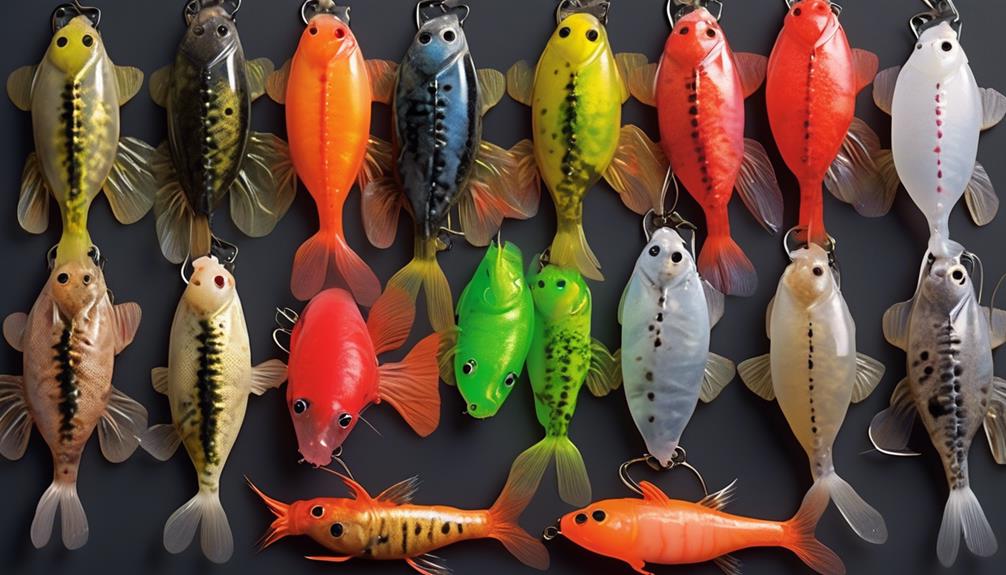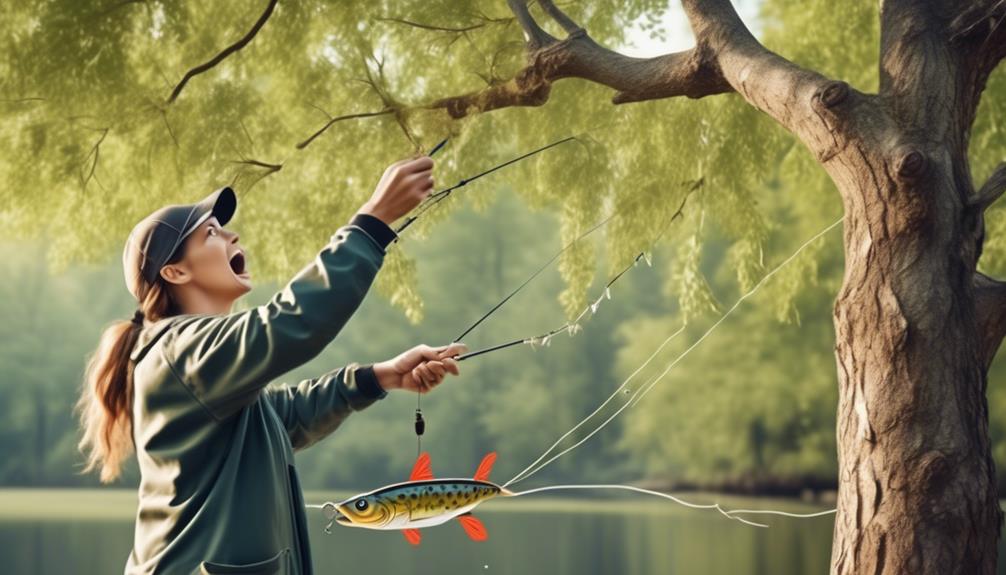When it comes to freshwater fishing, having the right lures can make all the difference. Spinnerbaits, crankbaits, jigs, soft plastic baits, topwater lures, swimbaits, jerkbaits, and spoon lures – these are just a few of the essential tools in any angler's arsenal.
Whether you're targeting bass, trout, pike, or panfish, the right lure can be the key to a successful day on the water. But with so many options out there, how do you know which ones are worth your time and money?
Well, we've done the research and compiled a comprehensive list of the top 15 freshwater fishing lures to help you make an informed decision.
Spinnerbaits
When targeting predatory fish in freshwater, spinnerbaits are a versatile and effective choice due to their ability to mimic the movement of natural prey. The blade design of spinnerbaits plays a crucial role in attracting fish. The most common blade designs are the Colorado and the Willow.
The Colorado blade is wider and slower, creating more vibration and allowing the spinnerbait to be retrieved at a slower pace. On the other hand, the Willow blade is more narrow and faster, producing intense flashes and enabling a faster retrieval. Understanding the behavior of the fish and the water conditions can help you choose the right blade design for the day.
Regarding retrieval techniques, there are various methods to consider. The 'slow-rolling' technique involves retrieving the spinnerbait slowly, allowing the blades to throb and the skirt to pulsate, making it an ideal technique for targeting inactive or deep-dwelling fish.
Conversely, the 'burning' technique requires a fast retrieval, causing the spinnerbait to move quickly across the water's surface, imitating a fleeing baitfish and enticing aggressive strikes from fish near the surface.
Lastly, the 'yo-yo' technique involves lifting and dropping the spinnerbait in a yo-yo motion, creating an erratic movement that can trigger reaction strikes from nearby fish.
Crankbaits
Pivoting from spinnerbaits, crankbaits are another versatile and effective choice for targeting predatory fish in freshwater due to their realistic swimming action and ability to dive to specific depths. When using crankbaits, it's essential to master different retrieval techniques to entice strikes. The most common methods are steady retrieve, stop-and-go, and twitching. Experimenting with these techniques can help you figure out what works best on any given day.
In terms of colors, natural patterns like shad, bluegill, and crawfish tend to be reliable choices. However, don't be afraid to try brighter or unconventional colors if the water is murky or if the fish seem to be responding to something different.
One of the great advantages of crankbaits is their ability to target specific depths. Different crankbaits are designed to dive to different depths, and this can be crucial for success. Shallow diving crankbaits are ideal for working over shallow structures or when fish are feeding near the surface. On the other hand, deeper diving crankbaits are excellent for exploring deeper water or targeting fish holding near the bottom.
It's also important to consider the water conditions. For example, in muddy or stained water, using crankbaits with prominent rattles and exaggerated wobbling action can help fish locate the lure more easily. In clearer water, a more subtle presentation may be necessary to avoid spooking fish. Understanding these variations in depth and water conditions can significantly enhance your crankbait fishing success.
Jigs
If you're looking for a versatile and effective lure for freshwater fishing, jigs are an excellent choice due to their ability to attract a wide variety of fish species. Jigs are incredibly versatile and can be used with various jigging techniques to entice fish at different depths.
When it comes to jigging techniques, mastering the art of jigging up and down, or side to side, can make all the difference in attracting fish. Varying the depth at which you fish with jigs is also crucial. Depending on the fish species and environmental conditions, adjusting the depth variations can help you find where the fish are actively feeding.
Jig color selection is a critical aspect of fishing with jigs. It's essential to have a selection of colors to adapt to different water and light conditions. Darker colors like black and blue are great for murky or low-light situations, while lighter colors such as white and chartreuse work well in clearer water.
Additionally, incorporating trailer options such as soft plastic grubs, craws, or trailers with paddle tails can enhance the jig's appeal and increase your chances of a successful catch. The right trailer can add more action and lifelike movement to the jig, making it more enticing to fish.
Soft Plastic Baits
Soft plastic baits are another versatile and effective option for freshwater fishing, offering a wide range of possibilities for enticing various fish species. These lures come in a variety of shapes, sizes, and colors, allowing you to adapt your presentation to different fishing conditions and target species.
When using soft plastic baits, consider the following tips to maximize your success:
- Weighted Hooks: Using weighted hooks with soft plastic baits can help you achieve the desired depth and casting distance. The added weight also allows for a more natural presentation, especially when fishing in deeper waters or areas with strong currents.
- Color Selection: Pay attention to the color of the soft plastic bait you choose. Different colors can be more or less effective depending on water clarity, weather conditions, and the type of fish you're targeting. It's a good idea to have a variety of colors in your tackle box to adapt to changing circumstances.
- Action: Soft plastic baits can be rigged in various ways to achieve different actions in the water. Experiment with different rigging techniques to find the best presentation for the specific fishing situation you're facing.
- Matching the Hatch: Consider using soft plastic baits that mimic the natural prey of the fish in your area. Matching the hatch can significantly increase your chances of attracting bites from discerning fish.
- Versatility: Soft plastic baits can be used in a wide range of fishing techniques, including Texas rigging, Carolina rigging, drop-shotting, and more. Their versatility makes them a valuable addition to any angler's arsenal.
Topwater Lures
When fishing in freshwater, topwater lures can be an exhilarating choice for enticing fish to strike near the water's surface. These lures are designed to create enticing actions that mimic distressed prey, making them irresistible to predatory fish. The lure action is a crucial aspect of topwater fishing, as it's what attracts fish to strike. Different topwater lures have varying actions, such as popping, splashing, or walking.
Poppers create a popping sound and splash when jerked, imitating a wounded baitfish. On the other hand, walking lures have a side-to-side action when retrieved, resembling a struggling prey. Understanding the unique action of each lure is essential for effectively attracting fish.
When it comes to retrieval techniques, the key is to experiment with different methods to find what works best for the specific lure and fishing conditions. For poppers, a popular technique is to jerk the rod tip to create the popping action, then pause to allow the ripples to dissipate before repeating. This imitates a wounded baitfish struggling on the surface.
Alternatively, walking lures require a steady retrieve with subtle rod twitches to create the side-to-side action. The goal is to mimic the movements of natural prey and trigger a fish's predatory instincts.
Swimbaits
Swimbaits offer an alternative approach to enticing fish in freshwater, providing a different action and presentation than topwater lures. These lures can be incredibly effective when targeting various freshwater species, and mastering the right techniques can significantly improve your success rates.
Here are some key points to consider when using swimbaits:
- Vary your retrieval speed: Experimenting with different retrieval speeds can help you find the optimal pace to trigger strikes from fish.
- Choose the right size and color: Matching the size and color of your swimbait to the local forage can enhance your chances of enticing fish.
- Target structure and cover: Casting swimbaits near structures such as docks, fallen trees, or weed beds can yield great results as fish often use these areas for shelter and ambushing prey.
- Utilize a stop-and-go retrieve: Pausing your retrieve intermittently can mimic injured prey, often triggering aggressive strikes from predatory fish.
- Adjust your presentation depth: Swimbaits come in various sinking rates, allowing you to adjust your presentation depth to match the fish's current activity level.
When targeting species such as largemouth bass, pike, muskie, walleye, and trout, these effective techniques can help you make the most of your swimbait fishing experience. By mastering these methods, you can increase your chances of hooking into some impressive freshwater game fish.
Jerkbaits

Considering the effectiveness of swimbaits in freshwater fishing, jerkbaits offer an alternative method for enticing fish with their erratic action and lifelike appearance. When using jerkbaits, mastering the retrieval techniques is crucial. The 'jerk' part of the name comes from the sharp, upward snaps of the rod that create the bait's characteristic darting motion. This erratic movement mimics a wounded baitfish, triggering predatory instincts in fish and enticing them to strike. Varying the cadence and length of your jerks can help determine what the fish are responding to on any given day.
Another important aspect of using jerkbaits effectively is the color selection. Jerkbaits come in a wide array of colors, and choosing the right one can significantly impact your success. In clear water, natural colors like silver, white, or perch patterns can be effective. In murkier water or low light conditions, brighter colors like chartreuse, orange, or firetiger can be more visible to the fish.
It's also essential to consider the forage in the area you're fishing. Matching the color of the jerkbait to the prevalent baitfish can improve your chances of a successful outing.
Spoon Lures
Mastering the retrieval techniques for jerkbaits is crucial, and a similar level of finesse is required when using spoon lures in freshwater fishing. Spoon lures are renowned for their ability to attract a wide variety of freshwater fish species. Here's what you need to know about using spoon lures effectively:
- Casting Techniques: When using spoon lures, it's essential to practice your casting techniques. These lures are typically heavier than other types, so mastering the art of accurately casting them is crucial for success.
- Retrieval Methods: The key to using spoon lures effectively lies in the retrieval methods. Experiment with different retrieval speeds and patterns to find what works best for the specific fishing conditions and the behavior of the fish you're targeting.
- Weight and Size: Consider the weight and size of the spoon lure based on the type of fish you're targeting and the water conditions. Heavier and larger spoon lures are suitable for deeper waters and larger fish species, while smaller ones are ideal for shallower areas and smaller fish.
- Color Options: Spoon lures come in a wide range of colors, and the right color choice can make a significant difference in attracting fish. Consider the water clarity and the prevalent forage to determine the most effective color options for your fishing expedition.
Using spoon lures effectively involves honing your casting and retrieval techniques, selecting the right weight, size, and color options based on the fishing conditions and the behavior of the fish you're targeting.
Frequently Asked Questions
What Are the Best Techniques for Using Topwater Lures in Different Weather Conditions?
In rainy weather, topwater lure techniques can be effective for summer conditions.
When it's windy during spring fishing, using soft plastic baits can yield good results. Adjust your technique for the conditions – in windy weather, cast against the wind and vary your retrieve.
In rain, focus on creating noise and commotion on the water's surface. Adapt to the conditions and experiment to find what works best for the specific weather.
Can Soft Plastic Baits Be Used Effectively for Catching Different Types of Freshwater Fish, or Are They Best Suited for Specific Species?
Soft plastic baits can be effective for catching various freshwater fish species when used with the right fishing techniques. By modifying soft plastic baits to mimic the prey of your targeted species, you can increase their effectiveness.
Different retrieval methods and presentations can also make a significant difference. Learning to adapt your soft plastic bait to different conditions and species will enhance your success in freshwater fishing.
Are There Any Specific Colors or Patterns of Crankbaits That Work Best for Different Water Conditions or Times of Day?
When choosing crankbaits, consider the best color choices and ideal patterns for different water conditions.
In the morning, go for natural colors like shad or crawfish patterns.
As the day progresses, switch to brighter or more reflective colors.
In the evening, darker hues work well.
For murky waters, opt for brighter colors.
For clear conditions, choose more natural or translucent patterns.
Adjusting lure colors for the time of day can make a big difference in your fishing success.
What Are Some Common Mistakes Anglers Make When Using Swimbaits, and How Can They Be Avoided?
When fishing with swimbaits, common mistakes include improper retrieval and using the wrong size.
To avoid these, focus on maintaining a steady retrieve and matching the bait size to the local forage.
Additionally, casting distance plays a crucial role, so be mindful of your target area and adjust your technique accordingly.
How Can Anglers Modify or Customize Spoon Lures to Make Them More Effective for Targeting Specific Freshwater Fish Species?
To modify spoon lures effectively, try customizing them with different colors and sizes. Experiment with adding or removing hooks to suit specific freshwater fish species.
Incorporate effective topwater techniques for more versatility. Soft plastic can also be used to enhance the lure's appeal.
Conclusion
So there you have it, the top 15 freshwater fishing lures reviewed.
Whether you're a beginner or seasoned angler, having a variety of lures in your tackle box can make all the difference.
From spinnerbaits to soft plastic baits, there's a lure for every situation.
So go ahead, stock up on these lures and get ready for some great fishing adventures!



